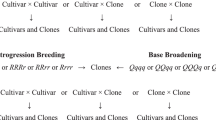Summary
Theoretical models to estimate the coefficient of double reduction in tetraploid organisms and the standard error of this estimate are derived. Using these models, we were able to estimate the coefficient of double reduction for several loci in tetraploid potatoes, Solanum tuberosum L., through examination of segregating isozyme loci in a series of 4x-2x crosses and in haploid progeny derived from six cultivated tetraploid potatoes. Tetraploid x diploid crosses are useful for estimating the frequency of double reduction because of the availability of homozygous diploid tester lines and the large number of tetraploid progeny generated via the functioning of 2n pollen. The strength of haploid analysis is the examination of diploid progeny. However, it is frequently difficult to obtain large numbers of progeny for testing. Based on our results, we conclude that double reduction occurs sporadically in tetraploid potatoes.
Similar content being viewed by others
References
Brucher H (1964) El origen de la papa (Solarium tuberosum). Physis 24:439–452
Burnham CR (1962) Discussions in cytogenics. Burgess Publ, St. Paul, Minn.
Douches DS, Quiros CF (1987) Use of 4x-2x crosses to determine gene-centromere map distances of isozyme loci in Solanum species. Genome 29:519–527
Douches DS, Quiros CF (1988) Genetic strategies to determine the mode of 2n egg formation in diploid potatoes. Euphytica 38:247–260
Geiringer H (1948) Contribution to the heredity theory of multivalents. J Math Phys 1:246–278
Geiringer H (1949) Chromatid segregation of tetraploids and hexaploids. Genetics 34:665–684
Haldane JBS (1930) Theoretical genetics of autopolyploids. J Genet 22:349–372
Hawkes JG (1956) Taxonomic studies on the tuber-bearing Solanums I. Solanum tuberosum and the tetraploid species complex. Proc Linn Soc London 166:97–144
Hawkes JG (1967) The history of the potato. J R Hortic Soc 92:207–224; 249–262; 288–302
Hougas RW, Peloquin SJ (1958) The potential of potato haploids in breeding and genetic research. Am Potato J 35:701–707
Howard HW (1970) Genetics of the potato. Solanum tuberosum L. Logos Press, London
Howard HW (1973) Calyx forms in dihaploids in relation to the origin of Solanum tuberosum. Potato Res 16:43–46
Kotch GP, Peloquin SJ (1987) A new source of haploid germplasm for genetic and breeding research. Am Potato J 64:137–142
Martinez-Zapater JM, Oliver JL (1984) Genetic analysis of isozyme loci in tetraploid potatoes (Solanum tuberosum L.) Genetics 108:669–679
Mather K (1935) Reductional and equational separation of the chromosomes in bivalents and multivalents. J Genet 30:53–78
Mather K (1936) Segregation and linkage in autotetraploids. J Genet 32:287–314
Matsubayashi M (1960) Studies on the haploid plants of Solanum tuberosum. II. Meiotic chromosome pairing in the polyhaploid plants. Jpn J Breed 10:195–202
Muller HJ (1914) A new mode of segregation in Gregory's tetraploid primulas. Am Nat 48:508–512
Quiros CF, McHale N (1985) Genetic analysis of isozyme variants in diploid and tetraploid potatoes. Genetics 111:131–145
Staub JE, Kuhns LJ, Grun P, May B (1984) Genetic basis of isozyme variation for alkaline phosphatase and glucose phosphate isomerase in Solanum. Theor Appl Genet 67:505–513
Stebbins GL (1957) Genetics, evolution and plant breeding. Indian J Genet Plant Breed 17:129–141
Stuber CW, Wendel JF, Goodman MM, Smith JSC (1988) Techniques and scoring procedures for starch gel electrophoresis from maize (Zea mays L). Tech Bull 286 NC Agric Res Serv, North Carolina State University, Raleigh, N.C.
Swaminathan MS (1954) Microsporogenesis in some commercial potato varieties. J Hered 45:265–272
Swaminathan MS, Magoon ML (1961) Origin and cytogenetics of the commercial potato. Adv Genet 10:217–256
Author information
Authors and Affiliations
Additional information
Communicated by E.J. Eisen
Rights and permissions
About this article
Cite this article
Haynes, K.G., Douches, D.S. Estimation of the coefficient of double reduction in the cultivated tetraploid potato. Theoret. Appl. Genetics 85, 857–862 (1993). https://doi.org/10.1007/BF00225029
Received:
Accepted:
Issue Date:
DOI: https://doi.org/10.1007/BF00225029




